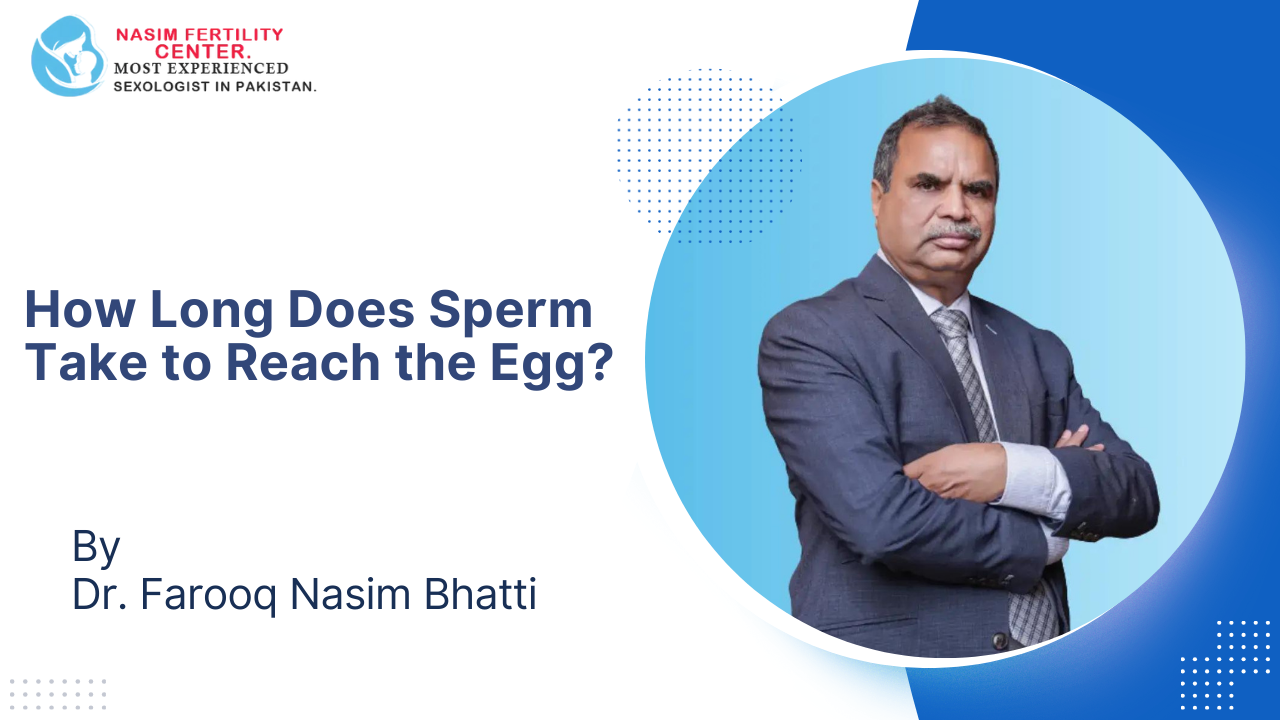
One of the most common questions couples ask when trying to conceive is: “How long does it take sperm to reach the egg after sex?” This question is not only natural but also very important for anyone planning a pregnancy or facing fertility concerns.
The journey of sperm from ejaculation to reaching the egg is complex and fascinating. Some sperm may reach the fallopian tube within minutes, but the actual process of fertilization may take hours or even days, depending on timing and biological conditions.
In this article, Dr. Farooq Nasim Bhatti, Pakistan’s first American Board of Sexology-certified sexologist with 30+ years of clinical experience, explains the science behind sperm travel, the factors that influence timing, and what couples need to know for improving fertility.
Quick Answer – How Fast Can Sperm Reach the Egg?
Fastest sperm: Can reach the fallopian tube in 15–45 minutes after ejaculation.
Average sperm journey: Most sperm take several hours to reach the egg.
Fertilization window: Even if sperm arrive early, the actual fertilization process may take up to 24 hours once ovulation occurs.
Sperm survival: Healthy sperm can survive in the female reproductive tract for 3–5 days, waiting for the egg to be released.
Step 1: What Happens During Ejaculation
When ejaculation occurs, millions of sperm are released into the vagina. However, only about 200–300 sperm (out of millions) actually make it close to the egg. The female reproductive system is designed to filter out weaker sperm, allowing only the healthiest ones to progress.
Semen also contains fluids that protect sperm and give them the energy needed to travel through the cervix and uterus. Within minutes, sperm begin their journey upwards.
Step 2: Journey Through the Cervix and Uterus
After ejaculation, sperm enter the cervix (the gateway between the vagina and uterus). This is often the first big challenge because cervical mucus consistency depends on the woman’s cycle:
During ovulation: Cervical mucus is thin, watery, and helps sperm move quickly.
Other times: It is thick and sticky, making sperm travel much harder.
Once through the cervix, sperm swim through the uterus toward the fallopian tubes. This distance is several centimeters, but for a sperm cell that is only 50 microns long, it’s like running a marathon.
Step 3: Reaching the Fallopian Tube
Only the strongest sperm survive the journey and enter the fallopian tube. Studies show some sperm can arrive in as little as 15 minutes, while most take a few hours.
However, reaching the tube is not enough. Sperm must undergo a process called capacitation — a biochemical change that makes them capable of fertilizing the egg. This process takes 6–8 hours on average.
Step 4: Waiting for the Egg
Fertilization is only possible if an egg is present. The egg is released during ovulation and remains viable for 12–24 hours.
If sperm arrive before ovulation, they can wait for up to 3–5 days inside the reproductive tract. This is why having intercourse a few days before ovulation can still lead to pregnancy.
If sperm arrive after the egg has already disintegrated, fertilization cannot happen. Timing is everything.
Factors That Influence How Fast Sperm Reach the Egg
The time it takes for sperm to reach and fertilize the egg depends on several factors:
Sperm Health: Motility (movement ability) and morphology (shape) play a huge role. Poor-quality sperm may never reach the egg.
Cervical Mucus: Fertile mucus during ovulation helps sperm swim faster.
Timing of Intercourse: Sex during the fertile window (5 days before ovulation + day of ovulation) gives the best chance.
Female Reproductive Health: Blocked fallopian tubes, endometriosis, or uterine abnormalities can delay or prevent sperm from reaching the egg.
Lifestyle Factors: Smoking, alcohol, stress, poor diet, and lack of exercise can reduce sperm quality and speed.
How Fertilization Actually Happens
Once sperm reaches the egg, only one sperm will successfully penetrate and fertilize it. When this happens:
The egg’s membrane changes to block other sperm.
The genetic material from the sperm combines with the egg.
Conception begins, leading to embryo development.
This fertilization process usually happens in the ampulla (the widest part of the fallopian tube). The fertilized egg then begins its journey to the uterus, where implantation happens after 5–7 days.
Common Myths About Sperm Travel Time
Many couples have misconceptions about how fast sperm reach the egg. Let’s clear a few:
Myth 1: Pregnancy happens instantly after sex.
In reality, it takes hours to days for fertilization and another week for implantation.Myth 2: All sperm reach the egg.
Out of millions, only a few hundred get close, and usually only one fertilizes the egg.Myth 3: Position during sex affects sperm speed.
Gravity or sexual positions have minimal effect; sperm are designed to swim.
When to See a Specialist
If a couple has been trying to conceive for over a year (or 6 months if the woman is over 35), it may be time to consult a fertility specialist.
Dr. Farooq Nasim Bhatti has helped thousands of men and couples address fertility issues such as low sperm count, poor motility, erectile dysfunction, premature ejaculation, and hormonal imbalances.
His approach is science-based, confidential, and holistic, addressing both physical and psychological causes of infertility.
FAQs About Sperm and Fertilization
Q1: How long can sperm survive inside the female body?
Healthy sperm can live 3–5 days, waiting for the egg.
Q2: How quickly can pregnancy happen after sex?
If sex happens during ovulation, fertilization may occur within hours, but implantation takes about a week.
Q3: Why do most sperm never reach the egg?
The female reproductive system acts as a natural filter to ensure only the healthiest sperm reach the egg.
Q4: Can lifestyle improve sperm speed and quality?
Yes. A balanced diet, exercise, avoiding smoking and alcohol, and managing stress can significantly improve sperm health.
Q5: How do I know if sperm are healthy?
A semen analysis performed by a qualified specialist like Dr. Farooq Nasim Bhatti provides information on sperm count, motility, and morphology.
Conclusion
So, how long does it take sperm to reach the egg? The answer: some sperm may reach the fallopian tube in minutes, but fertilization usually takes several hours, and conception depends on perfect timing between sperm arrival and egg release.
For couples struggling with fertility, understanding this process is the first step. With his 30+ years of expertise, international certifications, and thousands of successful treatments, Dr. Farooq Nasim Bhatti is a trusted name in male fertility and sexual health in Pakistan.
If you’re searching for the best sexologist in Pakistan or looking for professional guidance on male infertility, premature ejaculation, erectile dysfunction, or sperm health, book a confidential online consultation with Dr. Farooq Nasim Bhatti today.
Disclaimer
This information is for educational purposes and not the treatment. For treatment, you need to consult the doctor.

Dr. Farooq Nasim Bhatti (MBBS, FAACS – USA, Diplomate: American Board of Sexology, CST, HSC – Hong Kong, CART – Malaysia & China) is a qualified medical sexologist with 30+ years of experience. He has presented 21+ research papers internationally and treats sexual dysfunction through sex therapy, counseling, and pharmacotherapy to restore natural sexual function without temporary medication.

Regain Confidence with Our ED Solutions
Explore effective treatments for erectile dysfunction. Take charge of your intimacy today.


